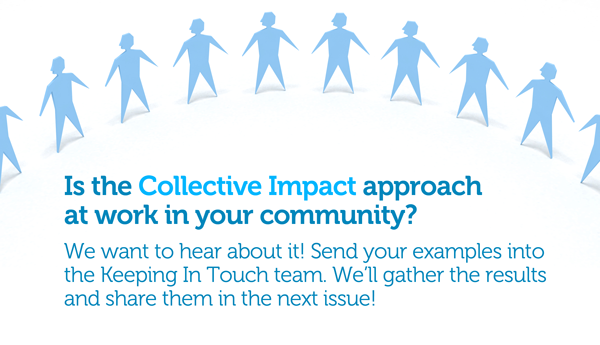Using Collective Impact to Push Social Change
[hr]
We would encourage you to read through the website article and see if you can identify an example of the Collective Impact approach at work in your community. Please send your examples in to us to share with other KIT Newsletter readers to jennie@froghollow.bc.ca.
[hr]
Collective Impact (CI) describes the process whereby a core group of community leaders decide to abandon their individual agendas in favour of a collective approach to reaching a common goal.
One example of this process is Strive, a Cincinnati nonprofit, which pulled together more than 300 leaders of local organizations, including the heads of influential private and corporate foundations, city government officials, school district representatives, the presidents of 8 universities and community colleges, and the executive directors of hundreds of education-related nonprofit and advocacy groups, through a carefully structured process, to focus on a single set of goals, measured in the same way.
Collective Impact is distinctly different to collaboration. Unlike most collaborations, CI initiatives involve a centralized infrastructure, a separate dedicated staff, and a structured process that leads to a common agenda, shared measurement, continuous communication, and mutually reinforcing activities among all participants.
Collective Impact posits that large-scale social change comes from better cross-sector coordination rather than from the isolated intervention of individual organizations. However, funder and nonprofits alike tend to overlook the potential for CI because they are used to focusing on independent action as the primary vehicle for social change.
While technical problems (e.g. funding college scholarships, building a hospital, installing inventory controls in a food bank) respond well to an individualized approach, adaptive problems (e.g. improving public health), by contrast, are complex, the answer is not well known, and even if it were, no single entity has the resources or authority to bring about the necessary change. Reaching an effective solution to an adaptive problem requires learning by the stakeholders involved in the problem, who must then change their own behaviours in order to create a solution.
The 5 Conditions of Collective Success:
- Common Agenda. Collective Impact requires all participants to have a shared vision for change, one that includes a common understanding of the problem and a joint approach to solving it through agreed upon actions. Funders can play an important role in getting organizations to act in concert, by aligning their requirements to the communally-agreed central principles and adopting the agreed measurement tools for their reporting.
- Shared Management Systems. Developing a shared management system is essential to collective impact. Collecting data and measuring results consistently, using web-based systems, on a short list of indicators at the community level and across all participating organizations, keeps efforts aligned and optimizes accountability and experiential learning. Looking at results across multiple organizations enables the participants to spot patterns, find solutions, and implement them rapidly. [In the Strive example, preschool groups programs discovered that children regress through the summer break before kindergarten. By launching a “summer bridge” session, implemented simultaneously in all pre-school programs, they increased the average kindergarten readiness scores throughout the region by an average of 10% in a single year.]
- Mutually Reinforcing Activities. Collective Impact initiatives depend on a diverse group of stakeholders working together, by encouraging each participant group to undertake the specific set of activities at which it excels, in a way that supports and is coordinated with the actions of others, through a mutually reinforcing plan of action. Each stakeholder’s efforts must fit into an overarching plan if their combined efforts are to succeed. The multiple causes of social problems, and the components of their solutions, are interdependent. Coordinated action allows each participant group to chart its own course consistent with the common agenda and informed by the shared measurement of results.
- Continuous Communication. Developing trust and creating a common vocabulary takes time. Participants need regular (monthly or bi-weekly) meetings, supported by external facilitators and following a structured agenda, often over several years, to develop this working basis of trust and shared goals.
- Backbone Support Organization. Creating and managing a Collective Impact initiative requires a separate, dedicated organization and staff with specific skill sets (e.g. project manager, data manager, and facilitator) to serve as the backbone for the entire initiative. A CI initiative also requires a highly structured process that leads to decision-making.
Funding for Collective Impact Initiatives
Collective Impact requires funders to support a long-term process of change without identifying any particular solution in advance. This requires a fundamental change in how funders see their role. Funders who want to create large-scale change are recommended to follow four practices:
- Take responsibility for assembling the elements of a solution.
- Create a movement for change.
- Include solutions from outside the nonprofit sector.
- Use actionable knowledge to influence behavior and improve performance.
Funding a CI initiative costs money, but it can be a highly leveraged investment. A backbone organization with a modest annual budget can support a CI initiative of several hundred organizations, magnifying the impact of millions of dollars in existing funding.
Note: Strive is now working to produce process templates to support other Collective Impact initiatives.
Click here to access this article.

